Basic Operation Concepts¶
We explain the basic operation concepts of the Halftone effect (called the "plugin" below).
Halftone Overview¶
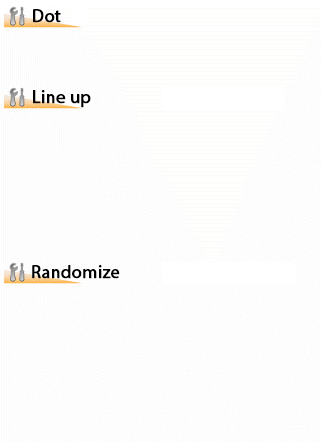 |
| Halftone Overview |
Dot¶
For convenience, we call the smallest unit shape drawn by this plugin a "dot".
Dots have the basic parameters of a figure as an object, such as color, radius (size), shape, aspect, and angle, which are adjustable by the user.
However, the user does not adjust these parameters for each dot individually, but applies them to groups of aligned dots.
| Dot Shapes | |||||
|---|---|---|---|---|---|
|
|
|
|
|
|
|
| Circle | Square | Round- square |
Cross | Diamond | Star |
Aligned Dots¶
The basic state of halftone is achieved by first aligning dots at regular intervals. Changes to the basic parameters of a dot are applied to the entire group of that dot.
 |
| Dots aligned at specified interval |
Randomization¶
You can randomize the attributes of each individual dot in a group of dots.
 |
| Randomization applied to size, aspect, and angle |
Effectors¶
Effectors refer to luminosity maps used to apply effects to the properties of dots.
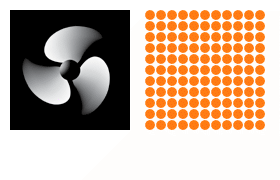 |
| Luminosity map (left) and effect on dots (right) |
Effector Details¶
Effect Map¶
The effect map is a luminosity map that expresses the strength of the effect with a value of 0 to 1.0.
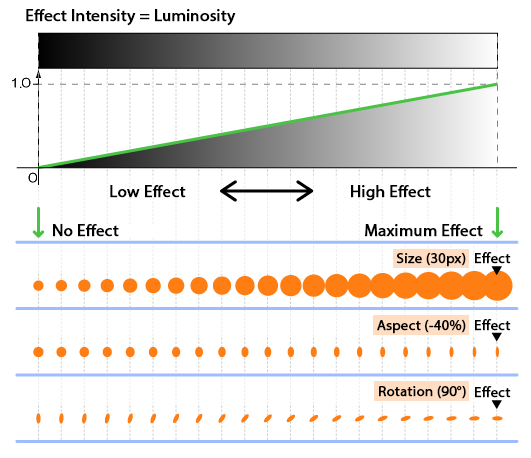 |
| Relationship between effect strength (=luminosity) and effect result |
From the "Effect Map" pulldown menu, you can choose whether to use a standard map provided by the plugin or a custom map.
| Standard effect maps provided | |||
|---|---|---|---|
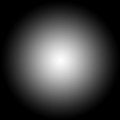 |
 |
 |
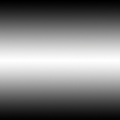 |
| Radial | Radial Mirror | Linear | Linear Mirror |
3 Types of Effects: ABS, Ratio and Offset¶
ABS, Ratio, and Offset are the 3 different types of effects that affect the properties of dots (Size, Aspect, Rotation, Opacity). Understanding the differences between these effects will help you use effectors effectively.
Difference in control for a dot rotation of 0° to 360° |
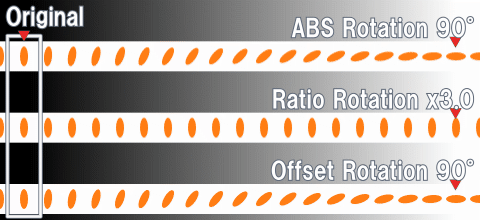 |
Please note how, at maximum effect strength in the example rotation above, ABS maintains a 90° angle regardless of the original dot angle, Ratio rotates 3 times for 1 rotation of the original dot, and Offset always maintains a 90° offset relative to the original dot.
ABS¶
ABS is a control for specifying absolute values.
The effect of an ABS parameter will be for the controlled value to approach the specified ABS value regardless of the original dot value.
It is suitable when you want to fix the value at the maximum effect point.

Ratio¶
Ratio is a control for specifying ratios or scaling factors.
Since it is a ratio, it has no effect if the original value is 0.
It is suitable when you want to apply an effect proportional to the original parameter.

Offset¶
Offset is a control for applying offsets or differences to values.
Since it is an offset, it produces an effect even if the original value is 0, unlike the Ratio control, and it does not overwrite changes to the original value with a fixed value like the ABS control.
It is suitable when you want to obtain an effect even when the original value is 0, such as for Rotation and Aspect.

Combining ABS, Ratio, and Offset¶
When ABS, Ratio, and Offset are used for the same property value in a single effector, the result of the formula below is applied at the maximum effect point.
ABS value × Ratio value + Offset value = Dot property value at maximum effect point
 |
| Combining ABS, Ratio, and Offset for the Size parameter |
Color Blending¶
Color blending within an effector applies a color determined by the dot color and the blend color, using the blend mode, as the color at effect strength = 1.0. It performs a gradient interpolation from the dot color to the effector color according to the effect strength.
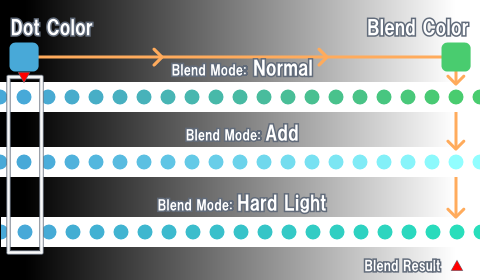 |
| Effector color blending |
Shift Hue¶
Shift Hue is a parameter that shifts the hue according to the effect strength.
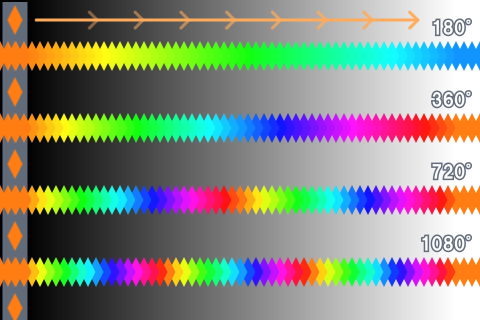 |
| Effect of Shift Hue |